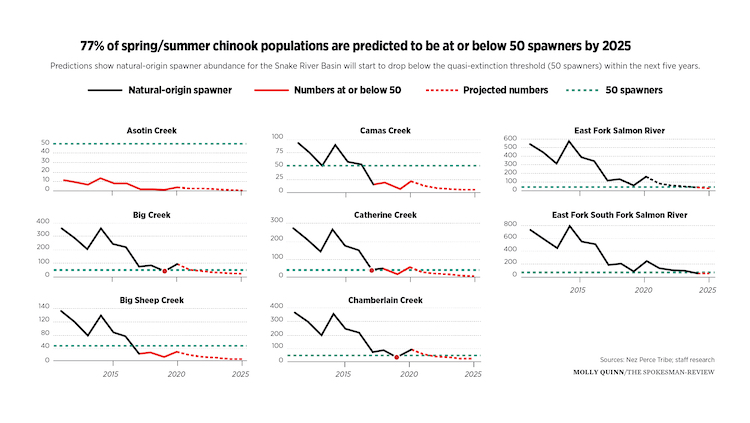forum
library
tutorial
contact

Replacing Benefits of Snake River Dams
Would Cost Billions
by Nicholas Geranios
Seattle Post-Intelligencer, June 9, 2022
|
the film forum library tutorial contact |

|
Replacing Benefits of Snake River Dams
by Nicholas Geranios
|
 SPOKANE, Wash. -- The benefits provided by four giant hydroelectric dams on the lower Snake River in Washington state can be replaced if the dams are breached to save endangered salmon runs, according to a new report released Thursday.
SPOKANE, Wash. -- The benefits provided by four giant hydroelectric dams on the lower Snake River in Washington state can be replaced if the dams are breached to save endangered salmon runs, according to a new report released Thursday.
But it would be expensive.
Finding other ways to provide electricity, irrigation and enabling commerce would cost between $10.3 billion and $27.2 billion, said the report commissioned by Washington Gov. Jay Inslee, a Democrat, and U.S. Sen. Patty Murray, D-Wash.
The draft report does not make any recommendations on whether the four dams should be breached. A decision on that divisive issue is expected later. Instead, the report allows the public, tribes, river users and other stakeholders to provide input over the next month that will inform that decision.
"We continue to approach the question of breaching with open minds and without a predetermined decision," Inslee and Murray said in a press release.
"Every community in the Pacific Northwest knows the value and importance of our iconic salmon runs--and every community recognizes the importance of salmon to our economy and cultural heritage," they said. "We each remain firmly committed to saving our salmon."
Breaching the dams would significantly improve the ability of salmon and steelhead to swim from their inland spawning grounds to the Pacific Ocean, where they spend most of their lives, and then back to their original spawning grounds to procreate and die, the report said.
Major benefits of the dams include making the Snake River navigable up to Lewiston, Idaho, allowing barges to carry wheat and other crops to ocean ports. Eliminating the dams would require truck and rail transportation improvements to move crops, the report said.
The dams also generate electricity, provide irrigation water for farmers and recreation opportunities for people, the report said.
The dams have many supporters, including two GOP members of Congress representing eastern Washington state. The dams are also supported by barge companies, farmers and other business interests. Breaching them would require an act of Congress.
Republican U.S. Reps. Dan Newhouse and Cathy McMorris Rodgers of eastern Washington introduced a bill on Thursday to protect the dams, which are located in their districts. "Breaching the four lower Snake River dams would be harmful to our communities, our environment, and our economy," Newhouse said.
"What's alarming is trying to breach them at a time when families in Eastern Washington are paying record-high energy costs just to keep the lights on this summer," McMorris Rodgers said.
But the chairman of the Yakama Nation said the dams must be breached.
"Our people are salmon people," said tribal council chairman Delano Saluskin. "When the salmon thrive, we thrive; but when they suffer, our people suffer too."
Exploring the Columbia River Basin in 1805, Lewis and Clark wrote of waterways so full with salmon that you could all but walk across on their backs.
In the late 1800s, up to 16 million salmon and steelhead returned to the Columbia River Basin every year to spawn. Over the next century and a half, overfishing whittled that number down. By the early 1950s, just under 130,000 Chinook were returning to the Snake River.
Construction of the first dam on the lower river, Ice Harbor, began in 1955. Lower Monumental followed in 1969, Little Goose in 1970, and Lower Granite in 1975. The dams stretch from Pasco, Washington, to near Pullman, Washington, and stand between migrating salmon and 5,500 miles (8,850 kilometers) of spawning habitat in central Idaho.
The dams have fish ladders, but too many of the salmon die as they swim through the dams and across slackwater reservoirs on their migrations.
In 1991, Snake River salmon and steelhead were listed as endangered species, requiring production of a federal recovery plan. Over the next three decades, environmental organizations sued the federal government six times, arguing that the recovery plan was inadequate.
The most recent lawsuit, in 2016, resulted in a four-year study of the environmental impact of the dams. Although it found that breaching the dams would be the most effective salmon recovery action, federal agencies ultimately decided against it.
The U.S. government has spent more than $17 billion trying to recover Snake River salmon, through improvements to fish ladders and other measures, with little to show for it. In 2017, the number of Chinook salmon returning to the Snake River dropped below 10,000.
The reduction in the salmon population is also a blow to the endangered Southern Resident killer whale population. More than 90% of the whales' diet is salmon, which come from a variety of places including the Snake River system.
Dam supporters blame declining salmon runs on other factors, such as changing ocean conditions.
Last year, U.S. Rep. Mike Simpson, R-Idaho, unveiled a competing $33.5 billion plan to bring back Snake River salmon. It has bogged down, failing to win support from other Republicans, Democrats and some environmental groups.
The centerpiece of Simpson's plan is breaching the four dams, at a cost of up to $1.4 billion. The rest of the money would go toward replacing the renewable electricity the dams generate, improving salmon habitat, and helping farmers who rely on the dams for irrigation and barge transport of their crops.
learn more on topics covered in the film
see the video
read the script
learn the songs
discussion forum
